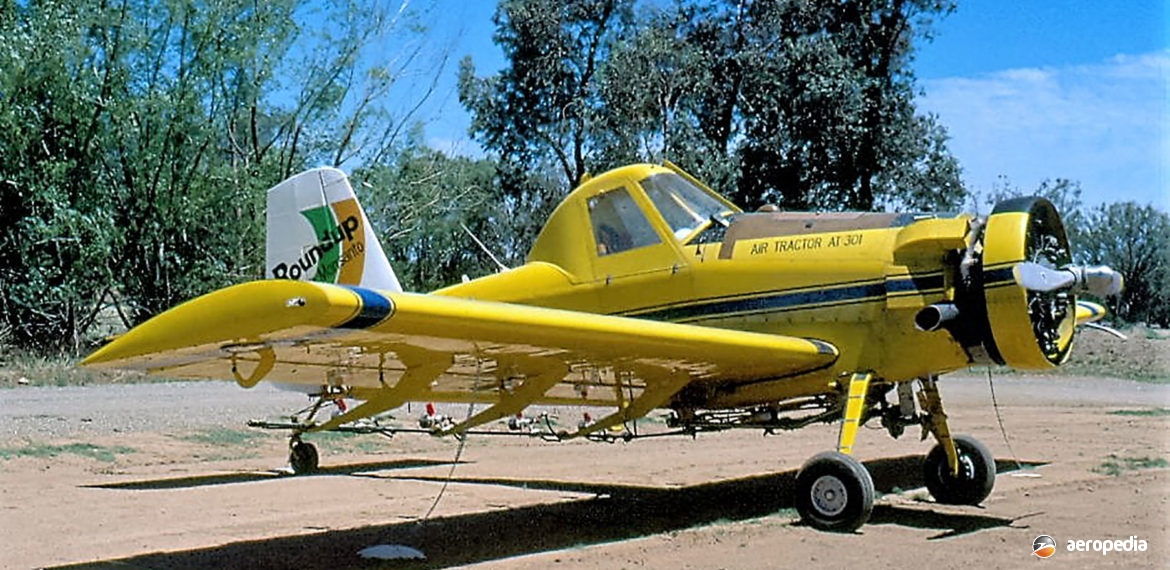Photograph:
Air Tractor AT-301 VH-JAI (c/n 301-0579) at Barellan, NSW in July 1989 (David C Eyre)
Country of origin:
United States of America
Description:
Single-seat agricultural monoplane
Power Plant:
One 448 kw (600 hp) Pratt & Whitney R-1340 nine-cylinder radial air-cooled engine
Specifications:
- Wingspan: 13.72 m (45 ft)
- Length: 8.23 (27 ft)
- Height: 2.59 m (8 ft 6 in)
- Wing area: 25.08 m² (270 sq ft)
- Max speed at sea level: 266 km/h (165 mph)
- Max cruising speed at 1,830 m (6,000 ft): 241 km/h (150 mph)
- Economical cruising speed at 2,440 m (8,000 ft): 225 km/h (140 mph)
- Stalling speed flaps down: 85 km/h (53 mph)
- Max rate of climb at sea level: 488 m/min (1,600 ft/min)
- Range with max fuel and no reserves: 563 km (350 miles)
- Empty weight: 1,656 kg(3,650 lb)
- Loaded weight: 3,130 kg (6,900 lb)
History:
The Air Tractor series of agricultural aircraft was designed in the USA by Mr Leland Snow. a well-known designer of agricultural aircraft, with more than 20 years experience in the field. Mr. Snow had previously designed aircraft for his company, Snow Corporation of Olney Texas, which was sold to North American Rockwell in November 1965. He left that company and went on to design the S-2 series of aircraft, which became known as the Rockwell S-2R Thrush, Thrush Commander, and so on. These were produced at Albany in Georgia. Later he moved to Wichita Falls in Texas and commenced work on the design of a new agricultural aircraft which was derived from the Snow series.
In July 1972 in rented premises at Olney he commenced construction of the prototype of a new design, the AT-300. This was of conventional layout and powered by a Pratt & Whitney R-985AN-1 engine which provided 336 kw (450 hp). The Air Tractor was a cantilever low-wing monoplane of light alloy construction. It had a 1,211 litre (266 Imp gal) hopper in the fuselage. It was of tubular steel construction and included a sealed cockpit within the structure. It had a cantilever wing of 13.71 m (45 ft) span and was of all-metal construction. The prototype AT-300 (N44200 – c/n 300-0001) took fifteen months to build and was flown by Mr Snow in September 1973, certification being received in March 1974.
Development moved on to the AT-301, and in 1975 twenty production aircraft were delivered. In June 1977 a turbine version was flown N4441S (c/n 301-0101), this becoming the AT-30, which was fitted with an Avco Lycoming LTP 101-A1A engine of 448 kw (600 shp), seventeen being delivered. A few had a larger hopper and an operating weight of 3,493 kg (7,700 lb).
The wings of the AT-301 were fitted with Fowler electrically-operated flaps. The fuselage was of welded steel tube, with quickly detachable light-alloy skin for internal inspection. A non-retractable tailwheel type undercarriage was fitted, with a cantilever spring, steel main gear and a castoring lockable tailwheel. A 1,211 litre (266.4 Imp gal) fibreglass hopper was mounted in the forward fuselage, with a Transland Gatebox, an Agrin Autics valve and strainer, stainless steel plumbing, and up to 68 nozzles in spraybars mounted below and just aft of the wing trailing-edges. Fuel capacity was 288 litres (63.3 Imp gals).
A number of variants of the AT-301 series was made available, all with the Pratt & Whitney radial engine. This led to turboprop variants which are dealt with elsewhere. More than 700 AT-301s were built, and some 19 have appeared on the Australian register, a couple of examples being converted to turboprop power during their careers. The AT-301 and AT-301A were similar, the latter being introduced in 1980 to provide for the installation of a larger hopper with a 0.97 m (3 ft 2 in) wide gatebox for high application rates of dry chemicals.
AT-301s registered in Australia have included: VH-FRC (c/n 301-0662), VH-HKC (c/n 301-0674), VH-TKS (c/n 301-0524), VH-FEI (c/n 301-0574), VH-JFA (c/n 301-0622), VH-LGJ (c/n 301-0220), VH-FAA (c/n 301-0278), and VH-LDJ/VH-NOW (c/n 301-0555).

